Wing Chun Kung Fu is one of those martial arts that constantly seems to get crapped on  constantly, particularly by the MMA crowd. They’ll trot out a few videos of some very poor Kung Fu practitioners who were stupid enough to enter full-contact tournaments, point to those practitioners’ cringe-inducing failures, and then pronounce that Wing Chun as a system is useless crap. I have a coworker who was chatting martial arts with me, once, and he mentioned that he had taken Wing Chun for a year or two. Just as I started to get interested, he announced, “But that crap doesn’t work. I quit that junk and started with MMA.”
constantly, particularly by the MMA crowd. They’ll trot out a few videos of some very poor Kung Fu practitioners who were stupid enough to enter full-contact tournaments, point to those practitioners’ cringe-inducing failures, and then pronounce that Wing Chun as a system is useless crap. I have a coworker who was chatting martial arts with me, once, and he mentioned that he had taken Wing Chun for a year or two. Just as I started to get interested, he announced, “But that crap doesn’t work. I quit that junk and started with MMA.”
His attitude is fairly common, and Wing Chun is a favorite whipping boy among martial arts pundits and trolls alike — both in real life and on the Internet. There are two reasons for this, I think. The first is that most of the people talking about Wing Chun really don’t understand it or know much about it. The second is that there is plenty of really bad Wing Chun out there, which doesn’t help.
There’s an English troll, some washed-up cop from the UK, who seems to spend every waking hour of his life (when he’s not on duty, presuambly) trolling martial arts forums looking to cause trouble. This same fellow, after training in Wing Chun (somewhere in Britain, I guess) for one year, posted a laughably arrogant, misinformed “review” of the entire system, pronouncing it useless and ineffective. He made mistakes that any beginner in a decent school would never make, which means either he trained at a terrible sch0ol (and they’re out there) or he’s an imbecile who doesn’t learn well. (Given what I’ve seen of him online, I lean towards the latter.)
This fellow was saying bizarre things like, “Wing Chun is off balance because all the weight is on the rear foot,” which of course isn’t how the stances in Wing Chun are supposed to work (the weighting is equal with perhaps a slight bias to the rear leg). He also commented that Wing Chun training was poor because “the wooden dummy makes a poor substitute for a heavy bag.” Anyone who’s trained in Wing Chun for even a little while should know that the wooden dummy is used to train structure and form. It is most certainly not a punching bag.
Ignorant commentary aside, however, just how effective is Wing Chun? I trained in it for perhaps three years before switching to study Liu Seong Gung Fu full time (in which I have since earned my black belt). It gave me a very good foundation and I remain impressed by it. After I left my kwoon, politics surrounding my leaving prompted my teacher to make some very negative, very false public statements about me, which is unfortunate (the peripheral fallout pretty much drove this teacher off the Internet for at least a while). That, however, has very little to do without how I felt about Wing Chun back then — or how I feel about it today.
When I started training in Wing Chun Kung Fu, I spent about three months wondering if the system was right for me at all. I even contemplated quitting a few times, once going so far as to contact my Sifu to speak with him about it. Wing Chun was different than most other arts I had studied to that point; the footwork was precise and demanding, the horse stance used for training was painful and seemed pointless, and chi sao practice was so boring I thought it was a complete waste of time.
My training to that point had been largely of the “short attention span” approach, as I flitted from style to style without committing. Reluctant to walk away from yet another school and worried that I was shortchanging myself by never testing for advanced ranks, I told myself to give it at least six months. That seemed like a fair amount of time in which to decide if the style was right for me. “If I’m still hating it, if I still feel like the clumsiest guy in class after six months, I’m not capable of learning it,” I told myself.
I’m very grateful I did not quit then. It’s true that since then I discovered a style that suited me even better, but that does not mean I think ill of Wing Chun. Had I stayed at that school I’m sure I would have come into conflict with my teacher inevitably, but that was a function of his maturity level and again had nothing to do with the style. (For that matter, my teacher was a skilled and accomplished martial artist, despite his personality issues.)
After the first few months of Wing Chun training, it was in the subsequent weeks and months that things started to come together. I “got it” as I trained, becoming more and more comfortable with the style and its application. More importantly, I began to see gains that pointed to the qualities I had observed in my Sifu: his incredible speed, his seemingly effortless flow, the “snap” to his techniques, and the tremendous power he generated in a body one hundred pounds lighter than my own.
While Wing Chun was not the only style I studied even then, it had a profound influence on me. I came to realize just how effective and efficient a close-quarters fighting art it is. Given my direct experience with Wing Chun, the degree to which it is condemned, dismissed, and even ridiculed by others still surprises me –though it shouldn’t.
Considering this, the fundamental question remains in the minds of many. It is a question answered derogatively by some who’ve spent years with the style, not to mention by the occasional fly-by amateur who has dabbled in Wing Chun without truly learning it as a system. The question remains, “Just how effective is Wing Chun?”
I find myself, as a strong advocate of Wing Chun as a realistic fighting system, defending a traditional martial art (TMA). This makes me, in the minds of some critics, a traditionalist — though the fact is that I am as far from a traditionalist as it is possible to be. I do not believe in defending tradition for its own sake, in holding up age or the Ancients as proof of an argument. I do, however, believe in finding value in the valuable wherever it may be, regardless of provenance.
I have no ego invested in Wing Chun as a system, especially now that I have left it. If it had not met my standards, I would not have trained in it — and perhaps I would have felt a sense of relief at the time this would have freed up in my schedule. I do not waste my time, which is at a premium given my busy lifestyle, engaged in the “illusion of competence.” This is why I know Wing Chun to be extremely effective — because I have experienced it personally, evaluated it objectively, and applied it vigorously.
Of Lineages and Schools
Discussing the effectiveness of Wing Chun is complicated greatly by the fact that not all Wing Chun is created equal. While I hate to admit it, the high ratio of poor instruction to good instruction available commercially is dismaying. There are multiple lineages of Wing Chun — chains of students and instructors, most of whom do things differently to varying degrees. (There is even at least one lineage of Wing Chun not associated with the famous Wing Chun master Yip Man.) Some lineages deemphasize, to their detriment, the lateral footwork that makes Wing Chun mobile and therefore effective. Others used flawed technical structure, such as tan saos (“dispersing hands”) or wu saos (“guarding hands”) held horizontally rather than properly angled. (A tan sao held horizontally has no deflecting power; a wu sao held horizontally is in invitation to broken fingers.)
I trained in the William Cheung lineage, but my instructor was a universalist who believed, at least early in his career, that all Wing Chun should be respected as Wing Chun. (He later, after becoming a student of another, higher-ranking teacher, became much less accepting in his attitudes.) He showed us structural variations accordingly and let us come to our own conclusions, in those first couple of years.
All lineages have their stories of how theirs is the “true” Wing Chun, all of these apocryphal at best. Such tales are irrelevant to me, for the efficiency of the system is not built on these histories (despite the petty politicking that occurs in the Wing Chun world).
A famous “fight,” which is still discussed today after years of bickering, once took place between William Cheung and a student from another lineage. The choppy video of this event is held up as “proof” of any number of spurious claims. “Cheung can’t fight,” is one. “Cheung got his ass kicked,” is another. “Wing Chun is not street effective,” some conclude. “Wing Chun people can’t grapple,” some argue. Of these, only the latter has even a little validity, though a single scuffle proves very little about the skills of those involved. Anyone, after all, can screw up or have a bad day, and nobody is alert to danger at all times (though arguably they should be).
An objective look at the video (which both sides claim has been edited to the benefit of the other) shows us that A) Cheung protects his center as he’s been taught to do; B) the aggressor mounts him and throws wild blow after wild blow; C) Every time Cheung tries to throw a leg up over his opponent, he slides across the gymnasium floor, providing the viewer with a valuable lesson on the ways in which terrain can screw up our best laid plans.
When the “fight” was over, neither party was injured. I’ve since heard from a member of the opponent’s lineage that, supposedly, Cheung’s face was swollen and he showed signs of a severe beating, but I’ve never heard that before or since from any other source, and I discount it as not believable.
So what does this tell us? It tells us almost nothing. From it we learn nothing about Wing Chun as a system (other than the need for cross-training in grappling to cover what is arguably a blind spot in Wing Chun, though some schools do train in “anti-grappling”). We learn relatively little about the two participants, other than that they didn’t hurt each other. We learn, simply, that politics can leave a black eye on a style that no amount of punching can inflict.
I believe there is a right way and a wrong way to perform certain techniques, even though some lineages teach the variations as acceptable. As always, reality is the deciding factor. In my kwoon, for example, we were taught to distribute our weight evenly on both feet for optimum balance and mobility. Anyone who tells you, therefore, that “Wing Chun is ineffective because the weight is placed primarily on the rear leg” is in error — though that error may be the product of poor teaching in a lineage or school imparting improper structure.
When we discuss the efficacy of Wing Chun, then, we must acknowledge that many schools and lineages teach different things. Where there is conflict, we must be biased towards those techniques and principles that offer the best REALISTIC results. All else is not “proof of Wing Chun’s ineffectiveness” — it is proof of poor teaching (or poor learning). The final arbiter is reality, not claims or stories or family trees. Wherever a better alternative exists in the pantheon of Wing Chun masters, it is that alternative that represents “true Wing Chun.”
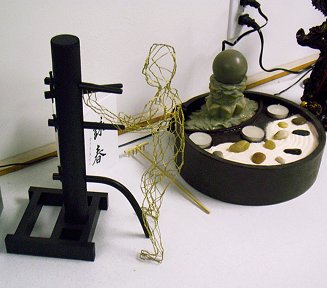
Just how effective is Wing Chun?
Train earnestly and you’ll find out.
Touch Reflexes and Sticky Hands
From the outset, I despised chi sao practice at my Wing Chun School. What was the point, I wondered, of these repetitive, stylized movements? It was so boring. These are common complaints and produce predictable proclamations from students of reality-based self-defense instructors (and even students of other TMAs). “There are better ways to spend your time,” they will state. “There are faster ways to learn effective self-defense. Chi sao is useless for fighting.”
While Wing Chun Kung Fu can be learned relatively quickly by the standards of TMA, it is true that it is not the fastest means of acquiring immediate self-defense skills. There are numerous combatives curricula available that provide this. Training in a martial art like Wing Chun, however, implies a commitment to development over the long term rather than in the short term.
I once wrote of a class in which I “attacked” my Wing Chun teacher with a rubber knife and he missed the initial intercept of my “blade.” His touch reflexes enabled him to perceive the force of my incoming attack and respond accordingly despite the initial miss. No amount of conscious thought can produce reflexes of this nature. When developed, touch reflexes are instinctive and make the fighter much more formidable. This is why my instructor was able to fight me without looking at me at least part of the time — and this is why I am now able to do the same, years later.
These are attributes that can be developed only over the long term. No number of five-hour seminars will make you more sensitive in the short term. I doubted the utility of chi sao until I loosened up and started seeing gains — at which point my strikes and my counters became faster and less conscious.
A student who dismisses the benefit of chi sao entirely does not understand its purpose. Those who admit that touch reflexes are of benefit, but who argue that there are better ways than “sticky hands” to develop it, are not providing a convincing argument against chi sao. They are simply arguing for a different means towards the same end.
Forms and Tradition
The practice of forms is closely associated with traditional Kung Fu and is also dismissed by amateurs and experts alike. When I studied Chidokwan Karate, I hated memorizing kata. A form is not a kata; the latter is a chain of techniques performed against an imaginary opponent or opponents, normally practiced with speed and power. A form, by contrast, is a physical catalog of techniques — a slow pantomime of what a style has to offer at the form’s level of development.
Syracuse Wing Chun Academy students perform Sil Lim Tao.
Critics of forms, particularly Sil Lim Tao (the first form of Wing Chun), complain that it is practiced slowly and with neither power nor resistance. “How,” they demand, “does this teach someone to fight?”
A form does not teach the practitioner “to fight.” A form does teach proper structure and, well, form for one’s techniques. It teaches the right angles, the proper distances, and the ranges of motion for those techniques. As a means of practice it is very useful. No amount of forms practice can take the place of combat drills, through which techniques are applied with speed and power against resisting opponents. As a reference tool for the mechanics of those techniques, however, the form serves a vital purpose in learning the style.
As a mental exercise, forms allow the practitioner to internalize a physical catalog of techniques and refer back to it. Frequently my Wing Chun Sifu would say, “From the form,” referring to the right way to execute a movement. Repetition is the best means of internalizing anything, while slow practice forces the practitioner to focus. Done correctly, Sil Lim Tao takes an excruciatingly long time to perform — with good reason. Thus, the forms critics knock as slow, repetitive, and useless are actually valuable teaching tools.
(I’ve heard stories of schools that make students practice Sil Lim Tao for a full year while teaching them nothing else, on the theory that this proves the student’s dedication. This would be like learning to drive while memorizing the manual but never once climbing into a car. It is also irrelevant to Wing Chun’s effectiveness once learned.)
As an aside, perhaps the stupidest critique I’ve heard of forms is that there is no need, in this day and age of DVD and digital cameras, for a physical catalog of techniques. No student can afford to refer back to “off-site storage” for a technique when the site in question is the brain of the practitioner. A form is a tool, but to be useful it must be carried by the user.
I mentioned full-contact tournaments before. The one that stands out most in my mind is one in which a wrestler faced a Wing Chun practitioner (who was probably of a different lineage than mine, judging by his low wu saos). The Wing Chun fighter walked towards his opponent. He stood there like a potted plant while the wrestler performed a shoot, took him down, and mounted him before pounding the living daylights out of him. The video is another of those pieces of “proof” that Wing Chun is not effective — or so critics assert.
In reality, the video is again proof of either poor teaching or a poor student. Even the beginners in my Wing Chun school were taught the importance of lateral footwork, of moving off the attacking line, of moving in to dominate space and overwhelm the opponent. My instructor often repeated the mantra, “Light on your feet, can’t be beat.” The footwork we learned was precise, demanding, fast, and effective.
In sparring with a friend from a hard style, my Wing Chun footwork served me well, as I was able — not once, but twice — to circle step around and in to strike him while avoiding kicks. Before my Wing Chun training, I would not have accomplished that. Of course, since then, I’ve found other ways of doing things… but that’s not the point.
Done properly, Wing Chun footwork is balanced, stable, and a good structural platform from which to generate power. At my kwoon we were taught to remain “rooted” while moving, retaining balance while aligning the body’s gates to hit with power.
Wing Chun Chain Punching
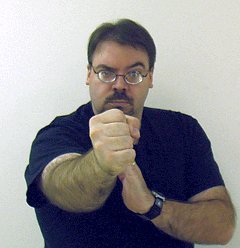 I’ve read some truly ignorant comments online regarding Wing Chun’s punching techniques, from the misconception that such punches rely on speed for power to the assertion that centerline punches cannot be thrown with power. An informed Wing Chun student knows that the reciprocating centerline punches of Wing Chun rely on the punching-side leg remaining rooted, while the leg, hip, shoulder, and elbow line up to deliver force with pile-driving efficiency. Beginners are generally slow at first, and practicing chain punches in the air is done without power to develop the tendons over the long term. This leads, however, to power-punching against focus pads and bags — and ultimately to students wearing Army-surplus flak jackets to absorb the impacts, at least in the school where I trained.
I’ve read some truly ignorant comments online regarding Wing Chun’s punching techniques, from the misconception that such punches rely on speed for power to the assertion that centerline punches cannot be thrown with power. An informed Wing Chun student knows that the reciprocating centerline punches of Wing Chun rely on the punching-side leg remaining rooted, while the leg, hip, shoulder, and elbow line up to deliver force with pile-driving efficiency. Beginners are generally slow at first, and practicing chain punches in the air is done without power to develop the tendons over the long term. This leads, however, to power-punching against focus pads and bags — and ultimately to students wearing Army-surplus flak jackets to absorb the impacts, at least in the school where I trained.
The famous one- and no-inch punch techniques (made famous by Bruce Lee) are Wing Chun punches. With practice, this phonebook parlor tick can be performed instinctively in combat, as the student learns to align his or her body to blast the opponent.
If I have any real complaints about Wing Chun punching, those complaints have nothing to do with power. Wing Chun punches are exceptionally powerful when performed correctly. No, my problem is that I generally do not prefer closed-fist strikes — because of the danger of damage to the hand in a real-life conflict. Fortunately, Wing Chun also contains chops and palm strikes, which I tend to favor. The vertical “sun fist” of Wing Chun punching is at least structurally superior to the horizontal fists used in Karate styles (which I refuse to do at all anymore). My instructor, who had extensive boxing experience, found closed-fist punching very natural. He hit hard, too.
The Wooden Dummy
A lot of ignorant practitioners of fighting arts treat the wooden dummy like a rigid heavy bag. Some, like the UK troll I mentioned, go so far as to complain that the dummy is a traditionalist failing of Wing Chun — because it makes a poor punching surface. All of these people are making a profound mistake. The wooden dummy is used to train the all-important structure of Wing Chun techniques — the angles and orientations that make this art (whose practitioners refuse to fight force with force or “muscle through” their techniques) — work. It can be used for a limited amount of conditioning, but the wooden dummy’s primary purpose is to provide reference points and feedback for the proper execution of techniques. It is not intended for use as a target for absorbing blunt trauma. A practitioner who brags about breaking the arms off his dummy does not understand how to use it. A student who pounds the dummy’s body like a heavy bag is ignorant and nothing else.
The wooden dummy trains structure. It is not a punching bag.
Power training in Wing Chun, by contrast, is performed with partners and with proper padding and bags — as in any art. Good schools integrate this training in their programs.
Vicious Lowline Kicking
High kicks are a liability in any fight. Wing Chun practitioners kick no higher than the groin or waist. Wing Chun kicks, when taught properly, are fast, non-telegraphic, and brutal. Critics will perceive a lack of kicking practice in the early stages of training, but this is due in part to the rigidity of the curriculum in some schools. The first form of Wing Chun contains no footwork and thus no kicks. Good Wing Chun schools give even beginning students practice in the kicking techniques that make Wing Chun especially brutal from the waist down.
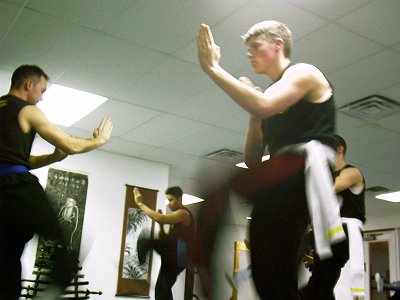
Even beginning students practice kicking at good Wing Chun schools.
Simultaneous Blocking and Striking
Forget all the nonsense you’ve heard about “trapping” or whatever other overcomplicated misconceptions you may have about Wing Chun. One of the core principles of the system is to “use both hands at the same time.” Wing Chun, in recognition of the fact that a strike beats a block every time, performs both simultaneously. This is lin sil die dar, doing two things at once. It is accomplished by slapping, jamming, or jerking the attacking limb while delivering a counterattack — preemptively, when possible.
Wing Chun practitioners also learn to deliver rapid, vicious, powerful blows, flowing into and over the opponent (preferably from the blind side as facilitated by lateral footwork). The “blocks” themselves are, in fact, painful strikes. One well-known Wing Chun instructor’s slapping block has, as my instructor reported, taken the hair off the attacking student’s arm. My instructor’s pak saos (“slapping hands”) were extremely powerful and routinely left my arms a pulsing red for minutes afterward.
Wing Chun striking is generally considered “linear,” though it has tight, circular elements. Regardless, it is extremely efficient, which is its hallmark. A good Wing Chun fighter strikes quickly and repeatedly, but with the power to back up his attack — thanks to the structure provided by his body mechanics and footwork.
Space Domination and Reality Combat Mechanics
In my Wing Chun school, students were taught to deescalate conflict with body language and verbiage that placed the hands up, backed the practitioner away from the threat, and protected the centerline in a casual approximation of the Wing Chun guard. From there it was a quick transition to a strike or a more formal guard, all while protecting one’s personal space, moving in to take the initiative.
This was both a physical and mental exercise, for students learned the appropriate statements to make to law enforcement after a fight, all while indicating to any observers that they did not want trouble before the fact. If the attack came, the practitioner’s hands were already up where they belonged.
Wing Chun fighters, when taught well, are also taught to strike preemptively when a credible threat presents itself within attacking range. They learn to close quickly when on the attack and to continue pressing to overwhelm the assailant. This is the essence of “reality based” fighting. It is, in short, ruthless and effective.
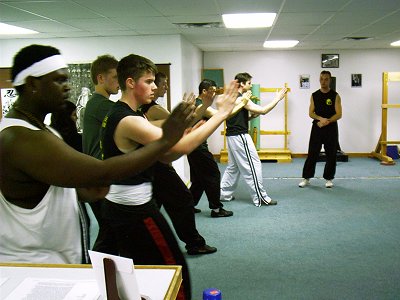
Students learn footwork to close efficiently and quickly.
Combat Drills and Realism
The training and the principles come together to combine with the student’s developing attributes in the combat drills of Wing Chun. More realistic than the low-contact dueling that is much sparring, combat drills enable students (properly padded when necessary) to train techniques full-speed, with full intent, against resisting opponents. A typical series of combat drills in our kwoon tooked the form of the “circle of death,” a jokingly named training tool that pitted students of all sizes and experience levels against each other. At other times, students in learned defenses against knives and guns as well as “street smart” defenses against common attacks.
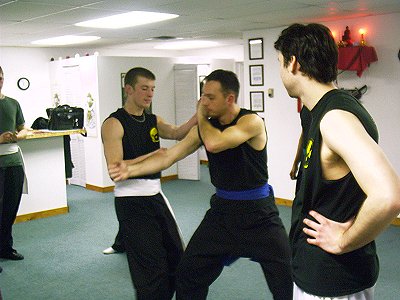
Combat drills in the “Circle of Death” offer training
that is more realistic than sparring.
Centerline Awareness
All of this leads to the central tenet of Wing Chun: centerline awareness. Wing Chun practitioners are obsessive about guarding the centerline, moving off the attacking line, and striking from the opponent’s blind side whenever possible. This is sound, effective fighting principle. Wing Chun ingrains centerline awareness indelibly.
How Effective is Wing Chun?
Taught properly, Wing Chun is an extremely efficient, effective art that is entirely compatible with military combatives and reality based fighting techniques. Not everyone who tells you otherwise is pontificating from ignorance — but many are. While a great many schools teach what I consider to be poor structure or less than ideal curricula, there are also many very good schools out there. I was fortunate that mine was one of them for most of the time I trained there.
The Wing Chun I came to know is fast, mobile, and powerful. It is rooted firmly in the reality of combat. It is an efficient, pragmatic fighting art, the mastery of which would serve anyone well. It is, therefore, quite effective and deserving of respect. While I have since moved on to a system more compatible with my personality and abilities, I will gladly tell anyone who asks of my high regard for Wing Chun Kung Fu.
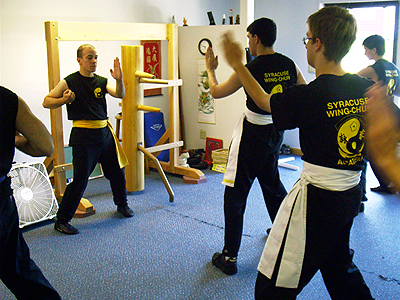
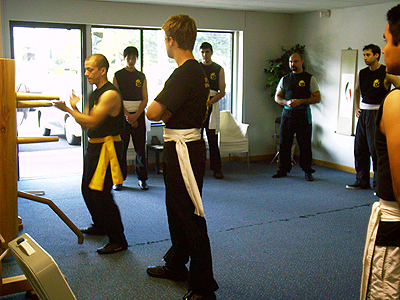
I enjoyed reading that.
I always like hearing from other Wing Chun practitioners.
It is a shame that something so effective is frequently the target for unfounded critique. Often, students only train a little and get bored. Anything worth having is worth working for. It does take some time to develop the muscle memory and sensitivity to form the habits required to become adept at this system. “It is simple, not easy.”
Regarding the wooden dummy:
There is another side to the dummy that should be addressed. In training it correctly, the student perfects his or her centerline – while at the same time learning how to move around an opponent ; At the later stages however, your live opponents should start to slowly resemble the dummy.
The ability to “will” the opponent into maintaining a false mental connection with his or her hands/feet long after they have been circumvented by the skilled practitioner is the often unseen key to effective Mook Yan Jong training.
ie: When an opponent throws a punch or a kick they expect it to land. The longer the opponent thinks this, the better – this is the time to fight. When a fighter is mentally connected to his or her striking – the fighter is at a disadvantage, because this connection can be manipulated by someone with practiced sensitivity. Ultimately, it is the application of this sensitivity which should be sought after when training with the Mook Yan Jong.
Best regards
~ a student of Ving Tsun.
i agree perfectly with your post. i dig what you said about the opponant slowly resembles the dummy and willing the opponent into mental connection with their own strikes-good stuff! if youre on facebook i invite you to friend me so that we may talk more of these things later. look for Chin Tsin or Chin Tsin Sandoval. im also from VING TSUN spelling, and my first study book was wayne belanohas wing chun compendium from Canada. i believe his teaching of Ip Mans lineage is structurally correct. i live in California. hope to speak w you soon, peace.
Good article. I think one important aspect many WC schools neglect is sparring. One can’t claim to be effective in combat without seriously training combat. However many people think that since WC is considered a soft style that serious sparring does not belong there. Pity.
Greetings.
While i dont agree with a few tiny details, i enjoyed reading this statement very much. I consider it a waste of ammo, to defend against the onslaught of MMA idiots.
You were spot on. A good martial arts teacher is the one who does not constantly belittle the other styles, or lineages.
All representants of MMA, and their fanbois – (basically pay TV customers, and those who profit from payTV arenafighting) share the same quality of utter failure at understanding that also “Traditional” martial arts can evolve, have been created out of necessity in most cases , and proved to work over generations against opponents that were after you very lives. Wing Chun in particular, is a “living” martial art… there is no “traditional technique” in it that is not verified and questioned from practitioners within the system… and only left as it is, if it profes to be the best variant. “Obsolete” techniques dont exist. Wing Chun is not Wushu-sports for shows… and as in every Martial Art and Sport, there is good and bad Students, good an bad Teachers. br, timo WT lineage since 1991.
Firstly, enjoyed the post – most of which I fully agree with.
You are right, there is a lot of bad Wing Chun taught out there. I study WingTsun (Leung Ting lineage) under the European WingTsun Organisation (EWTO), which is headed by GM Keith Kernspecht.
What GM Kernspecht has done, which I think is kind of where ‘traditional’ wing chun gets criticised is studied street fights in Europe via CCTV footage and applied WingTsun priciples to overcoming it.
The 100% weight on the rear leg stance you mention has its place. It is excellent for defending sweeps and rushes, but terrible at defending lateral attacks – but it wasn’t designed for it. So your SiFu was correct about being quick on your feet. We use the motto ‘hands follow feet’.
On chain punches, they are great for a beginner to practice a rapid, powerful attack, but the close quarters elbow and palm strikes offered in the Chum Kiu and Biu Ji forms are much more effective.
And in fact, where EWTO has really bought the art on is offering beginners many different forms of attack that used to be reserved for ‘advanced’ students.
And MMA is undoubtedly an effective and powerful combat sport that WingTsun will never compete with in the ring because the concepts and techniques we use are lethal and cannot be used in the ring. Hitting the throat or elbowing the face would soon make a mess.
Kicking is as you say another under appreciated skill. Bruce Lee wrote that you should practice kicking high, but always kick low in a fight. And WT’s counter kicking is an excellent example of this.
Anti-grappling is another example where WingTsun has borrowed elements from other arts. Yeah we don’t grapple well, but if someone grabs your hand to put you in a lock, punching them in the face is usually the most effective way of breaking the lock.
Again, good post. Its ashame you have moved on. The WingTsun I learn is very modern, very effective and is not at all a TMA, which I thought stood for Tycho Monolith Anomaly anyway – buy maybe I read too much Sci-Fi.
Definitely agree it breaks down a lot of what is floating around the martial arts community as I think every one has a fear of dedicating there time to the wrong training and teachers fear loosing students.
I’ve been training in wing chun for about 7years coming from a kickboxing back ground and the change it’s had on my personality and the way I interact on a personal a business level, from keeping eye contact in negotiations to using the central line thinking to always being straight to point with the questions that open an opponent up rather then raising there guard and also stopping a conection being made, same as using an asking hand rather then a punch or asking how there life is rather then why there late for work….
It’s the ease in which it penetrates all aspects of your life in a positive way.
Some people need to sweat and be battered to feel they’ve had a good session (I used to be one) but wing chun is about being the one that goes home to your kids once the worst happens on the street, no ref, no one saying you can’t kick to the groin or gauge there eye out, as when it comes down to your life there’s no sport in it….its win.. And that’s it…
I’ve sparred with so many different styles and they all have something to teach but wing chun and the way my teacher teaches, allows my eyes to be open to this rather then puffing my chest out and saying what I do is the best and every one else is wrong!
I gotta say I feel wing chun is the best style if you always take what works from other styles and keep adapting it, it’s not set in stone, it grows as the human race grows, as bodys change, as our perceptions of what’s possible change.
Take all the pads off and go bare knuckle with no rules and I will always favour wing chun , as any one who’s had the experience of walking in to a wing chun club and throwing your best moves on a guy half you size and then winding up shut down getting battered in such a controlled way will know the feeling of “I gotta learn this!”
p.s.
If you want to pick a teach that really knows what there doing in wing chun, avoid over muscled teachers, this alone will let you know they will not be able to master the basic ideas and motion of wing chun.
Also pick the smallest skinniest teacher you can find, if he can finish you with ease and you really try and hit him at every available moment! Don’t kid your self you tried to hit him…really go for it!!! That’s proof he can stop a man bigger then him that really wants to hit him! He now has something to teach you, to what degree and how long you will be there until you want to surpass with a better teacher is you own call but it’s a place to start!
That’s my rant any way!!
Peace
Thanks for your respectful post and for not jumping on the “WC is crap”-bandwagon while being exposed to whatever made you leave your WC-school and general public badmouthing.
I train for about three years in WC and I am still very sceptical about other WC implementations, living in a WC-melting-pot. What I learned so far about my understanding of WC is that there’s alot I don’t understand. Reading you trained for almost three years aswell I think your belief of understanding what WC is about is an illusion (Bruce Lee thought the same and he was for todays standards decent at most – still a good fighter for WC being reasonably effective at mid level). Conclusively I don’t see how you can differentiate between good and poor teachings other than personal testimony, which holds questionable value of truth. Thats also why you can’t answer the question on the effectivness of the system and your conclusion can be generalized for a large number of martial arts as every MA had at least one practitioner that used it successfully in combat.
I still agree on the specifics of WC (except maybe for the centerline, weight distribution and trapping).
Thanks again.
I think people get hung up on styles and politics in WingChun WC and don’t go deep enough into the modern biomechanics nor the traditional intentions…so i really applaud your approach.
Love your outlook on wingchun and thank you for providing the rational and positive explanation it needs in today’s pro-muscle-head, anti-wc climate.
I am 100% sure that your article here is not biased, not pre-determined and based on In-depth experience/research into the art. I leave this name to you because I have used this name to argue with many TMA con/Wing Chun con in a youtube clip named Wing Chun vs. Muay Thai where WC won. However, after numerous arguments, I discovered that these WC con just know nothing or at least done none exploration or research into TMA before making such comment. I have also wrote a blog about the central theory of several CMA. (I didn’t put Wing Chun onto it though I learnt WC as well because I haven’t made any RE-discovery of WC unlike those others that I have put on the blog. All my WC techniques were all taught by others) It is my pleasure to invite you to my blog.
Great website lots of useful info here
Only an extremely small number of people in the world know the real version of Wing Chun (about 15-20 people and almost all of them full-blooded Chinese). The rest know the fake version created by a Wing Chun master a few decades before Ip Man. He created the fake version to fool a guy who was spying on him as he taught his sons.
It was Ip Man who started teaching the fake version to 99% of the students in place of the real version. He only taught the real version to a handful of people and they only teach it to one or two people each (thus why I said about 15-20 people who know it). All of the publicly known masters of Wing Chun around the world are fakes because they were taught the fake version and they all teach students for profit (the real versions of the martial arts are always taught for free and who is being taught is always kept secret). So all of the students paying money to learn Wing Chun are learning fake Wing Chun and when they use it in a fight they suck. That is why Wing Chun has such a bad reputation as a useless martial art.
Great article. Too bad I found it so long after it was published.
The Wing Chun haters throw comments out there which, if you think about them for more than a second, quickly reveal their underlying foolishness.
I once read an article where the author claimed none of the high-level Wing Chun masters have any fighting skills.
Immediately I thought, “Oh, so you’ve met them all, have you? You’ve pressure tested them all, or at least seen footage of this?”
See? Doesn’t take much brain power at all.
Also, the criticisms that they think are unique to Wing Chun…are not. In fact, I wrote an article on that exact topic. You can check it out here:
https://www.martialjournal.com/your-wing-chun-criticisms-are-not-unique-to-wing-chun/
PS: Sorry for the shameless plug but, since it was related to the topic, I thought it might be okay to share that.